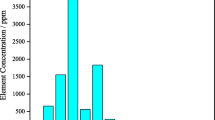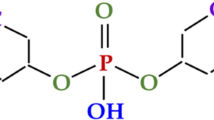Abstract
Phosphogypsum (PG) is classified as the main hazardous waste present in large quantities in Tunisia. It is a by-product of the fertilizer industry produced by a sulfuric acid attack on calcium phosphate. Storage and management of this toxic waste are environmental problems that concern many countries producing phosphate fertilizer, especially since waste is, in principle, prohibited by international law. Therefore, finding out a solution for the valorization or the removal of phosphogypsum has become a universal preoccupation and a topical research field. In this work, a fresh produced PG sample was firstly characterized by various analytical methods to determine its chemical composition as well as its rare earth elements (REEs) amount. Then, a hydrothermal conversion of the PG allowed obtaining an insoluble residue of calcium carbonate richer in REEs than the starting sample such that the enrichment rate was 66%. The obtained residue, considered after that as an interesting source of rare earths, was leached with a hydrochloric solution (5–6%) in the presence of ascorbic acid as reducing agent. The leaching method favored the migration of 89% of REEs to the leach liquor.





Similar content being viewed by others
References
Fertilizers Europe (2000) Best available techniques for pollution prevention and control in the European fertilizer industry: production of phosphoric acid. Booklet No. 4 of 8
Rashad AM (2017) Phosphogypsum as a construction material. J Clean Prod 166:732–743. https://doi.org/10.1016/j.jclepro.2017.08.049
Degirmenci N, Okucu A, Turabi A (2007) Application of phosphogypsum in soil stabilization. Build Environ 42(9):3393–3398
Papastefanou C, Stoulos S, Ioannidou A, Manolopoulou M (2006) The application of phosphogypsum in agriculture and the radiological impact. J Environ Radioact 89(2):188–198
Tunisian chemical group official website, history of TCG (2018) http://www.gct.com.tn/le-groupe/a-propos/histoire-du-gct/. Accessed 14 Mar 18
Kuryatny T, Angulski da Luz C, Ambroise J, Pera J (2008) Valorization of phosphogypsum as hydraulic binder. J Hazard Mater 160(2–3):681–687
Bourgier V (2007) Influence des ions monohydrogénophosphates et fluorophosphates sur les propriétés des phosphogypses et la réactivité des phosphoplâtres. Thesis, Saint-Etienne
Rutherford PM, Dudas MJ, Samek RA (1994) Environmental impacts of phosphogypsum. Sci Total Environ 149(1–2):1–38
Kaziliunas A, Leskeviciene V, Vektaris B, Valancius Z (2006) The study of neutralization of the dihydratephosphogypsum impurities. Ceram Silik 50(3):178–184
Lamzougui G, Nafai H, Bouhaouss A, Bchitou R (2005) Détermination de la teneur maximale des métaux lourds dans le phosphogypse. J Mater Environ Sci 7(6):2161–2169
Mulopo J, Ikhu-Omoregbe D (2012) Phosphogypsum conversion to calcium carbonate and utilization for remediation of acid mine drainage. J Chem Eng Process Technol 3:129
Kolokolnikov VA, Kovalev MI (2009) Technology for processing technical calcium carbonate obtained from phosphogypsum into pure calcium carbonate and rare-earth element concentrate. Chem Sustain Dev 17:387–393
Mattila HP, Zevenhoven R (2015) Mineral carbonation of phosphogypsum waste for production of useful carbonate and sulfate salts. Front Energy Res. https://doi.org/10.3389/fenrg.2015.00048
Oates JAH (1998) Lime and limestone: chemistry and technology, production and uses. Wiley-VCH Verlag GmbH, Weinheim
De Beer M, Maree JP, Liebenberg L, Doucet FJ (2014) Conversion of calcium sulphide to calcium carbonate during the process of recovery of elemental sulphur from gypsum waste. Waste Manag 34:2373–2381
Zhang W, Li X, Qu Z, Zhao Q, Chen G (2010) Facile solution synthesis and characterization of CaCO3 microspheres with urchin-shaped structure. Mater Lett 64:71–73
FrikEls (2017) China to become net importer of some rare earths. MINING.com. http://www.mining.com/china-become-net-importer-rare-earths/. Accessed 24 Mar 18
Binnemans K, Pontikes Y, Jones PJ, Van Gerven T, Blanpain B (2013) Recovery of rare earths from industrial waste residues: a concise review. In: International slag valorisation symposium, Leuven, 19-20/03/2013
Kolokolnikov VA, Kovalev MI (2009) Processing rare-earth element concentrate obtained from phosphogypsum. Chem Sustain Dev 17(261):266
Hammas I, Horchani-Naifer K, Férid M (2013) Solubility study and valorization of phosphogypsum salt solution. Int J Miner Process 123:87–93
Yang Y, Walton A, Sheridan R, Güth K, Gauß R, Gutfleisch O, Buchert M, Steenari B-M, Van Gerven T, Jones PT, Binnemans K (2017) REE recovery from end-of-life NdFeB permanent magnet scrap: a critical review. J Sustain Metall 3(1):122–149
Gergoric M, Barrier A, Retegan T (2018) Recovery of rare-earth elements from neodymium magnet waste using glycolic, maleic, and ascorbic acids followed by solvent extraction. J Sustain Metall. https://doi.org/10.1007/s40831-018-0200-6
SfarFelfoul H, Clastres P, Ben Ouezdou M (2005) Gestion des sous-produits industriels et developpement durable: cas du phosphogypse de sfax (tunisie). Sci Technol B 23:66–81
Luther SM, Dudas MJ, Rutherford PM (1993) Radioactivity and chemical characteristics of Alberta phosphogypsum. Water Air Soil Pollut 69:227–290
Jr Murray L C, Lewis B-AG (1985) Phosphogypsum waste anion removal by soil minerals. J Environ Eng 111(5):681
Shen Y, Xie A, Chen Z, Xu W, Yao H, Li S, Huang L, Wu Z, Kong X (2007) Controlled synthesis of calcium carbonate nanocrystals with multi-morphologies in different bicontinuous microemulsions. Mater Sci Eng A 443:95–100
Andersen FA, Brecevic L (1991) Infrared spectra of amorphous and crystalline calcium carbonate. Acta Chem Scand 45:1018–1024
Pereira F (2003) Ecole Nationale Supérieure des Mines et Université Jean Monnet, Thesis, Saint-Etienne
Habashi F (1985) J Chem Technol Biotechnol 35A:5–14
Pourret O (2006) Impact de la matière organique sur le comportement des terres rares en solution: étude expérimentale et modélisation. Thesis. Université de Rennes, p 1
Pourret O, Davranche M, Gruau G, Dia A (2007) Competition between humic acid and carbonates for rare earth elements complexation. J Colloid Interface Sci 305:25–31
Acknowledgements
Special thanks to the entire team of the Laboratory of Physico-Chemistry of Mineral Materials and their applications to the National Center for Research in Materials Science, Technopole Borj Cedria and all those who contributed directly or indirectly to the realization of this work. Project supported by the Ministry of Higher Education and Scientific Research of Tunisia.
Author information
Authors and Affiliations
Corresponding author
Ethics declarations
Conflict of interest
On behalf of all authors, the corresponding author states that there is no conflict of interest.
Rights and permissions
About this article
Cite this article
Masmoudi-Soussi, A., Hammas-Nasri, I., Horchani-Naifer, K. et al. Study of Rare Earths Leaching After Hydrothermal Conversion of Phosphogypsum. Chemistry Africa 2, 415–422 (2019). https://doi.org/10.1007/s42250-019-00048-z
Received:
Accepted:
Published:
Issue Date:
DOI: https://doi.org/10.1007/s42250-019-00048-z




